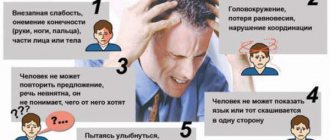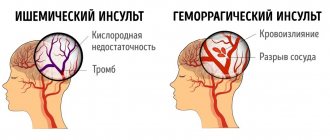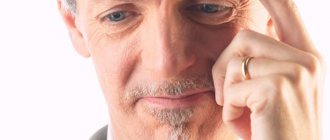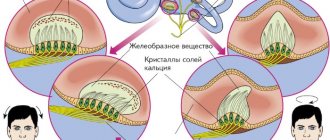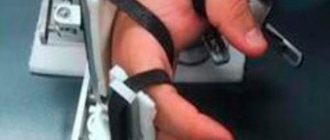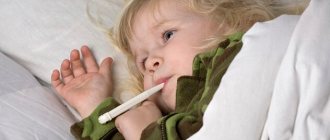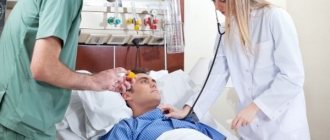1
Author of the article: Marina Dmitrievna
2017.11.01
4 746
Vessels
The leading cause of death in old age today is stroke. This disease is a disruption of the blood supply to areas of the brain, which leads to their death. Depending on the affected areas of the gray matter, certain functions are impaired in a person.
Brain after stroke
Most often, a patient after a stroke cannot swallow, move (fully or partially), speak clearly and coherently, or take care of himself hygienically. And only after long-term rehabilitation with outside help (relatives or professional caregivers) abilities return in full or incomplete, which depends on the degree and size of brain damage.
Swallowing disorder
- Weakened lip closure causes drooling and food falling out of the mouth.
- Weak cheek muscles cause food to accumulate behind the cheek.
- Weakness of the tongue muscles causes difficulty in forming and moving the bolus (which allows liquid to leak into the pharynx over the back of the tongue and enter the larynx before swallowing).
- Reduced posterior movement of the tongue root may contribute to retention of food debris in the mouth after swallowing.
- Insufficient closure of the larynx when swallowing food or deterioration in contraction of the muscles of the pharynx or esophagus with accumulation of food at the entrance to the esophagus leads to the entry of food particles into the newly opened larynx after swallowing.
Identifying Swallowing Disorders
Next, pay attention to the patient’s eating behavior (often associated with swallowing difficulties):
- increasing the duration of the act of eating;
- loss of interest in food, poor appetite or refusal to eat;
- avoiding specific types of food, such as hard and dry foods such as cookies;
- anxiety about upcoming food or liquid intake.
Recommendations for feeding patients with swallowing disorders
Teach the person to keep their head straight and in line with their body when swallowing food or liquid:
- if his head is tilted back, he will have difficulty swallowing. If the patient cannot support his head on his own, support him from behind by the neck and shoulders, so as to prevent the head from tilting back and help the patient control the position of the tongue;
- if, on the contrary, the patient’s head tilts excessively forward, support his chin with your hand from below or use a special fixing collar to support the head;
- if the patient always turns his head in one direction, sit next to him, but on the other side, and turn his head towards you with your hand.
The patient's knees should be slightly bent, placing a cushion/pillow under them:
teach a person to take food and bring it to the mouth with one hand or both hands at once.
if he can use a spoon to eat, make its handle thicker - this will make it easier for the person to hold the spoon
For these purposes, you can use a piece of rubber hose or make a wooden handle;
if the patient cannot absorb liquid, teach him to drink from a spoon;
advise the patient to take only a small amount of food or liquid into the mouth at a time;
Teach the patient to bring food or liquid to the middle of the mouth rather than to the side, and to put food into the mouth using the lips rather than the teeth;
instruct the patient to keep his lips pursed and his mouth closed when he chews or swallows food. If the patient's lower lip drops down, teach him to support it with his fingers;
Emphasize to the patient the importance of completely emptying the mouth after each spoon or mouthful of food to avoid accumulation of food on the side of the weak muscles of the tongue or cheek. The patient should use a finger to “sweep” the affected side and remove food after each swallow.
Ways to prevent aspiration:
- if necessary, periodically help the patient perform oral toileting: regularly remove mucus and saliva that accumulates in the mouth with a damp cloth. Remember that to keep the oral cavity clean, the patient’s teeth and dentures must be brushed at least 2 times a day;
- Do not serve drinks with solid food. Drinks should be given before or after to reduce the risk of aspiration. If you give the patient solid and liquid food at the same time, the liquid will push the solid food down the throat, and the patient will either swallow poorly chewed food or choke on the liquid;
- when the patient tries to eat in the way you teach him, praise him so that he wants to learn further;
- If you notice that the patient has problems swallowing food, ask him to cough. This protects the respiratory system;
- after feeding the patient, inspect his oral cavity, as food remaining in it may enter the respiratory tract;
- since the danger of aspiration persists for some time after eating, it is necessary to keep the patient in an upright position for 30-40 minutes after eating.
Published
Definition of stroke and dysphagia
Ischemic stroke is necrosis of a region of the brain that occurs as a result of insufficient blood supply, and hence oxygen starvation. This happens due to blockage of the lumen of blood vessels with cholesterol plaques or their sharp narrowing (spasm). Hemorrhagic stroke is a consequence of hemorrhage from a vessel into the brain parenchyma caused by its rupture.
Ischemic stroke
The vast majority of patients after a stroke have disorders of swallowing, chewing and sucking functions. This is due to the fact that to be able to swallow, many muscles sequentially contract, ensuring the safe movement of the bolus of food through the oropharynx. And this process is coordinated by several areas of the brain:
- First, food is moved by the tongue to the back of the oral cavity, for which the XII cranial nerve is responsible;
- Contact of the food bolus with the posterior wall of the oropharynx triggers the mechanism of closing the entrance to the trachea (leading to the lungs) and further movement of food using the IX and X cranial nerves;
- Next, the cricopharyngeal sphincter opens, the food bolus moves through it and further moves along the esophagus into the stomach, which provides a special swallowing center located in the medulla oblongata.
Video about the anatomical features of the swallowing function:
Important! When the swallowing center is damaged after a stroke, as a rule, the adjacent areas of the reticular formation, which interact with the respiratory and other centers, are affected. Thus, difficulty swallowing food in medicine is called dysphagia.
Depending on the severity of the stroke, it has different manifestations:
Thus, difficulty swallowing food in medicine is called dysphagia. Depending on the severity of the stroke, it has different manifestations:
- A single stroke of the cortex or subcortical areas (damage to a small area locally) leads to the manifestation of dysphagia within the first seven days. Moreover, in most cases, patients completely restore swallowing function after 20 days;
- With a brainstem stroke, the development of dysphagia is more likely. And to recover from lateral medulla oblongata syndrome, intensive corrective therapy for swallowing is necessary;
- After multiple strokes, dysphagia is more pronounced and requires more rehabilitation measures. Resumption of swallowing function in such patients takes a long time and does not completely restore the possibility of oral nutrition.
Brain after hemorrhagic stroke
But for any course of the disease, it is very important to know how to feed a patient after a stroke with a swallowing disorder. If you do not help a person cope with dysphagia or violate certain feeding rules, there is a likely risk of developing complications of this pathology
Using the probe
A gastric tube is a special device designed for feeding a person, which is used in the complete absence of a swallowing reflex. It is installed for a long period (3-4 months). A new tube is replaced three weeks after installation of the probe. A new portion of food is introduced with a Janet syringe or a special system that provides drip enteral nutrition.
It is recommended to feed the patient through a tube for the first time in a hospital setting . The patient is discharged with the probe already installed. This will allow the person to be restored at home. Thanks to the presence of this device, the rehabilitation period is greatly simplified. Medicines prescribed by the doctor are also given to the patient through a tube, which ensures that their active substances enter the body.
If, when using a probe, patients are diagnosed with a peristalsis disorder, this will negatively affect the patient’s recovery after a stroke. In this case, the patient is given a gastrotomy. This is a special installation that connects the stomach and the environment. The introduction of liquid food is carried out through the external opening.
Caring for a gastrotomy is quite complex. In addition, there is a risk of developing an infectious process. That is why, when using the device, it is recommended to strictly adhere to the doctor’s recommendations. The use of a tube or gastrotomy ensures adequate nutrition for the patient after a stroke, which contributes to a speedy recovery.
Rules for eating with dysphagia
When feeding against the background of problems with swallowing, you need to remember the following nuances:
- Food is divided into liquid and solid; both types of food are not given to the patient at one time. In this case, dense pieces of food will be difficult to pass through, so it is better to give preference to liquid products with a thick consistency.
- If reflex swallowing is impaired, liquids should also be chosen thick. Yogurt, jelly, fermented baked milk and similar textured products allow for a clear separation of sips. This reduces the likelihood that the patient will choke or choke. Water, fruit drinks, milk and juices flow in a continuous stream, which is why it is better to start giving them after the reflexes have been fully restored.
- During the recovery period, products that fall apart into crumbs (bread, cookies) or contain coarse dietary fiber (citrus fruits, cabbage) are prohibited.
- Before each new portion, you must make sure that there is nothing left in the patient’s mouth. The same should be done after finishing feeding.
- A person who has lost the ability to eat normally may need 30-40 minutes to consume one bowl of liquid soup. You can’t rush it, as this can increase the severity of nervous symptoms and disorders.
- Feeding is carried out in a sitting or half-sitting position; you cannot throw your head back.
The doctor decides what to do in cases where the patient’s consciousness is impaired and he aggressively reacts to the staff’s attempts to feed him. The process can be established with the help of loved ones; psychotherapy gives good results. Sometimes you have to return to installing a gastric tube or gastrostomy tube.
When choosing food, care should be taken to ensure that the food offered is easy to sample, chew and swallow. For maximum protection, it is recommended to avoid very hot or cold foods. It should be noted that the dishes should be tasty and aromatic, since with this approach it will be possible to stimulate the production of saliva and improve swallowing movements.
It is extremely important to avoid viscous foods that cause difficulty swallowing: fermented milk products, fruits, jams, syrups. You should avoid very dry, hard foods: crackers, toasted slices of bread
Cooked rice may stick together or be tough, so you should make sure that its consistency is optimal: easy chewing is guaranteed and there is no risk of sticking to the mouth.
Food should be soft and finely chopped, and it is advisable to combine it with soups and juices. If it is difficult to swallow pure water, it is advisable to use juice. It should be noted that diluted liquids can cause suffocation because they are not easy to smell. To thicken drinks, it is advisable to use milk powder with a minimum level of fat content.
The patient should eat food with the unaffected side of the mouth. In this case, you should make sure that the food has been swallowed, and your mouth remains completely clean. If food remains, it is recommended to sanitize using a clean finger. It is advisable to set aside 30–40 minutes for the meal. In this case, a sick person after finishing a meal should remain in a sitting position for about one hour.
Recommendations on nutrition, as well as the organization of meals, will allow you to count on a successful way out of the unpleasant situation that a person who has suffered a stroke had to face.
With the development of stroke, when necrosis of the brain area occurs, a disruption of the functioning of the main part of the human nervous system occurs.
Accordingly, the body is no longer able to implement the natural mechanism of the unconditioned reflex - as a result, problems arise with swallowing and passing food through the gastrointestinal tract. Even if the nerves responsible for the functioning of the esophagus, oropharynx and other upper parts of the gastrointestinal tract are not affected, the problem arises due to the fact that with necrosis of brain tissue, the neurocells that make up the centers for the regulation of autonomic functions die.
Rehabilitation methods
Restoring the swallowing process requires the use of several techniques. Initially, a compensatory technique is used. The patient is taught to correctly position the head and body while eating. The patient must develop a group of muscles that are involved in the swallowing process.
To do this, the patient is recommended to perform special gymnastics, which allows you to restore muscle mobility, as well as sensitivity of the oral cavity and larynx.
The patient must perform each exercise under the supervision of a specialist, which will have a positive effect on the result. The complex is developed only by a specialist after examining the patient in accordance with the severity of the pathological process. In order for the exercises to be highly effective, it is recommended to perform them regularly.
The set of exercises is aimed at developing the cheeks, palate and tongue. In most cases, patients are recommended to perform the standard complex:
- The patient is advised to puff out his cheeks and hold them for 15 seconds. After this we return to the starting position. The manipulation is repeated 5-7 times in one approach.
- The next step is to raise the tip of your tongue to the roof of your mouth. In this case, the mouth must be closed. After returning to the original position, open your mouth and raise the tip of your tongue again.
- The patient should regularly imitate swallowing movements.
- The next exercise is to pronounce the sound “y”. In this case, the lower jaw should move forward.
- At the next stage, the patient should open his mouth wide, as when yawning.
- Next, close your mouth and make the sound “m”.
- If the swallowing reflex is impaired, rinsing the mouth is recommended.
Each exercise should be performed in several approaches. The frequency of repetition of manipulations is from 6 to 9 times . If possible, the number of repetitions is regularly increased.
It is forbidden to force a patient to perform manipulations that he cannot perform. Initially, he is recommended to perform several exercises at a specified interval. If he fully copes with this task, then you need to add one exercise. It is recommended to repeat this until the patient performs the full complex.
Gymnastics should be carried out until the swallowing reflex is completely restored. To increase the effectiveness of exercises, patients are prescribed physiotherapy procedures, which involve exposure to current.
To combat the pathological process, the patient is recommended to undergo drug treatment. Proton pump inhibitors are recommended for the patient. The drugs are highly effective in patients with high acidity. If a bacterial infection occurs in parallel, then the use of drugs with antibacterial action is recommended . If conservative therapy is ineffective, surgical intervention is recommended.
Treatment of dysphagia should be comprehensive. The choice of methods is carried out by the doctor after a complete examination of the patient, which will restore the swallowing reflex as soon as possible.
Treatment to restore swallowing function after stroke
About two weeks after a stroke, two-thirds of people who had dysphagia (difficulty swallowing) begin to swallow again without problems.
Your doctor may recommend exercises to help coordinate the swallowing muscles and re-stimulate the nerves that control the swallowing reflex. These muscles will try different ways to compensate, depending on the individual's difficulties, and offer their owner methods to help food move down more easily.
Treatment – “Nothing by mouth”
If a person has serious difficulties with swallowing (dysphagia), then the “Nothing by mouth” method can be used to treat it, that is, without oral consumption of food and liquid. The amount of fluid and microelements necessary for the functioning of the body is maintained intradropwise.
Consult a nutritionist regarding the use of supplements that are necessary for this.
It is important when applying the “Nothing by mouth” treatment method that the person’s mouth does not become dry and painful, but is clean, fresh and free from infections. Dried saliva and mucus from the nose and throat can lead to discomfort and bad breath
Elimination of such negative phenomena as dry mouth and unpleasant odor from it can be helped by moisturizing a dry mouth with wet tampons, regularly brushing your teeth, and using ointment to moisturize your lips. Always check if the patient's speech is okay. Do this yourself or with the help of a speech therapist.
Treatment – changing the consistency of consumed liquids and foods
As swallowing is restored, the consistency of foods and liquids changes to suit changing individual needs. The patient's speech and speech therapist will advise how to change the texture of foods. This may mean that the patient requires soft foods or foods that are pureed before consumption. You need to know which foods are safe for a person with dysphagia to eat without pre-cooking, and which ones you should try to avoid.
Beverages and foods can be thickened using commercially available (such as fruit purees) or homemade (purées made from home-canned fruit in a blender) thickeners, which make liquids and pureed foods that are too runny, safer and easier to swallow. swallow them. Some pre-thickened juices with added pulp are commercially available.
Thickeners can be used as an additive when baking flour products.
Puréed fruit or yogurt can be easily made using a blender, while skim or whole milk powder, boneless fish, mashed potatoes or other starchy vegetables can be used to thicken the soup.
When writing this article, materials were used from the website www.stroke org.uk
Symptoms
Every patient who has suffered a stroke is required to be checked by doctors to determine whether the swallowing reflex is affected. Specialists conduct a test meal with the patient to determine the patient’s ability to feed independently. If dysphagia is detected, measures must be taken to eliminate the complication.
The main symptoms that characterize difficulty swallowing are:
- While eating and drinking, the patient begins to choke;
- The patient complains of food stuck in the throat;
- Eating food and even water occurs extremely slowly with great effort;
- Drinks leak from the patient's mouth and food falls out;
- While eating, the specialist may hear gurgling sounds;
- Food remains in the area of the mouth that is devoid of sensitivity;
- After eating, the patient feels a sensation of a foreign body in the throat and wants to clear it;
- When swallowing liquid, it flows out of the nose.
Exercises
Five months after the stroke, the difficulty with swallowing had decreased, but remained. We told the speech therapist about this. The doctor recommended doing special exercises and selected exercises for me. We started doing swallowing exercises every other day, in the late afternoon.
Drawing syllable
- I take a deep breath.
- I hold the tip of my tongue with my teeth (lightly, without injuring, not too much). I pronounce the syllable: NNNNNNAAAAAAA. I stretch out the sound as long as possible while I have enough air. While pronouncing the sound, I do not let go of my tongue and continue to hold it.
- 10 reps.
Saliva
- swallowing movements" (without food and without liquid): Inhale, hold your breath, swallow saliva and, without exhaling, cough two or three times (while holding your breath).
- 5 reps.
Language
- I move my tongue as far into my mouth as possible and hold it in this position for 1 second. Then I relax my tongue. I return to normal position.
- 5 reps.
A sip
- I take a sip (without food and without liquid). I take a sip with effort. But I don’t take it all the way, in the upper position of lifting the “Adam’s apple” (Adam’s apple), I linger for 2 seconds and then take a sip. I perform the exercise with effort.
- 5 reps.
Vowel sounds
- I pronounce the sounds “A”, “O”, “U”, “Y” in turn. I pronounce sounds with effort and pressure.
- 10 reps.
These exercises restore the functioning of the swallowing muscles.
It took about four months to learn to swallow again. The result is very good. At the moment there are practically no problems with swallowing. In addition to swallowing, gymnastics helped improve speech and partially established proper breathing during conversation.
Swallowing rules
In addition to gymnastics, we came up with several rules and follow them. They help overcome difficulty swallowing:
- I drink in small sips. Calm and smooth.
- I don’t eat in large pieces, I bite off the next piece only after I have chewed and swallowed the previous one completely.
- I don’t get distracted or talk while eating or drinking.
- We make sure that food and drink are not hot.
Restoring lost body skills after a stroke often has to be done simultaneously using several methods. This gives a really effective result and speeds up recovery. But I’m still far from Nikolai Yakovlevich Bogdanov)))
Complication of dysphagia
Between 65 and 95 percent of people who have a stroke suffer from dysphagia, which occurs within the first few days (up to 10). Of these, 10% require tube feeding, and 25-35% die.
In addition to the obvious threat to life, patients with impaired swallowing function who do not receive proper care after a stroke are susceptible to the following complications:
- Due to difficulties with eating and drinking, the patient does not receive enough necessary nutrients, which leads to a slowdown in many vital processes (manifested by a sharp and significant weight loss) and dehydration. This condition is fraught with the onset of catabolic processes in the body;
- Due to the disruption of the physiological mechanism in dysphagia that protects the lungs from food, food particles can enter the airways. This pathology is called aspiration; it is dangerous for the development of pulmonary infections, and hence pneumonia.
Aspiration pneumonia in patients who have had a stroke
Thus, the development of pneumonia in patients with impaired swallowing function after a stroke occurs in 30-50% of cases. The main reason for this is aspiration of the respiratory tract with the contents of the oropharynx and nasopharynx. This development of events worsens the survival prognosis by 2.5 times.
Therefore, it is extremely important to know how to properly restore the swallowing reflex after a stroke.
Diagnostic measures
If symptoms of pathology occur, the patient is recommended to be examined by a doctor. The specialist conducts a trial feeding of the patient, which allows him to determine the symptoms of the disease and make a preliminary diagnosis.
To confirm it, it is recommended to use additional diagnostic techniques:
- Videofluroscopy, which is the most informative for dysphagia.
- Electromyography.
- Pharyngeal or esrophageal manometry;
- Pulse oximetry;
- Fiberoptic endoscopic assessment of the swallowing reflex.
Diagnosis of the pathological condition must be comprehensive, which will allow the doctor to determine the extent of the disorder and prescribe effective treatment.
Diagnosis of swallowing disorders
A person who has had a stroke should have their swallowing function assessed before feeding. The attending physician identifies dysphagia using the following methods:
- clinical and anamnestic;
- clinical and neurological;
- clinical and instrumental.
The clinical and anamnestic method for identifying impaired swallowing function involves collecting an anamnesis (medical history) and examining the patient. This includes interviewing the patient and those caring for him (relatives or medical staff) for the manifestation of one or more symptoms of dysphagia (listed above). But there may be no complaints about signs of swallowing impairment after a stroke due to unawareness of the very fact of the disease or reduced sensitivity in the oral cavity. Then objective tests will be required.
Clinical and neurological examination consists of bedside clinical studies of swallowing function, which is the basis for the diagnosis of dysphagia. For this purpose the following is carried out:
- examination of the palate in a calm state and during phonation;
- diagnosing palatal and pharyngeal functions;
- testing for swallowing functions.
In this case, the following signs are taken into account: dysarthria and dysphonia, the presence of an altered, atypical cough, decreased or absent pharyngeal reflexes, the manifestation of cough immediately after swallowing liquid and a change in voice after a minute.
If two or more of the listed signs occur with dysphagia, the risk of aspiration is high, one predictor indicates a low risk, and the absence of such manifestations does not confirm the penetration of food debris into the respiratory system.
The clinical and instrumental method for determining dysphagia and aspiration in a patient who has suffered a stroke consists of:
- Videofluoroscopy, which is an X-ray examination of the swallowing organs using barium;
- Transnasal fibroendoscopy, which consists of inserting a naso-endoscope through the nostril to the soft palate, which provides a sufficient level of video monitoring of the swallowing process in real time;
Transnasal fibroendoscopy for dysphagia after stroke
In addition to the above, pulse oximetry, electromyography of submental muscle groups, as well as various screening tests are used.
Such diagnostic methods make it possible to determine the consistency of food acceptable for a specific level of dysphagia, a comfortable position for the patient, or a method for safe feeding. As a result, in addition to identifying pathology, an optimal scheme is developed that allows for rapid recovery after a stroke.
What tests are required for dysphagia?
If a person is in a condition, there are opportunities to conduct examinations and determine the characteristics of the health condition. Moreover, the situation is easier if the victim can remain in a sitting position. The nurse may suggest drinking a small amount of water. So, the main task is to swallow water one teaspoon at a time.
If a person can swallow the suggested amount of plain water painlessly and without coughing or choking, one can count on a favorable result. The test can be repeated until the person drinks a small glass of water on his own. The achieved result will confirm the successful treatment of dysphagia and restoration of impaired functions.
If the problem persists, your doctor may do other tests. The main task is to fully assess the health status of a person suffering from a stroke. Among the possible examination options is video fluoroscopy, which involves the patient swallowing a small volume of liquid containing barium. It is assumed that barium will highlight on the x-ray the correct place where disturbances occur during swallowing movements.
Correct diagnostics will allow you to determine the cause of the violations in order to try to eliminate the problem, despite its presence.
Stroke rehabilitation how to restore health Consequences and measures taken
Consequences of a stroke and how possible it is to restore health after it
A stroke almost always leaves behind some consequences, which often cause the patient to lose their ability to work.
As a result of rehabilitation measures, it is possible to restore the health of a patient who has suffered a stroke to one degree or another. In some cases, complete restoration of health is possible, but this can only be done when there is no death of nerve cells as a result of the stroke. If the nerve cells in the lesion are still partially dead, as a result of rehabilitation actions, their functions are taken over by other, healthy nerve cells. Sometimes the resulting lesion is so large that its functions cannot be restored and the patient can only adapt to it; in such cases, patients often use devices such as crutches, wheelchairs, and so on.
The consequences of a stroke are less likely to be restored if the lesion was located in functionally significant areas of the brain that are responsible for motor and speech functions, and also if the lesion was very large. Functions are poorly restored in old age, as well as if a person had a fairly long-term chronic cerebrovascular accident and other diseases before the stroke. Brain functions are restored more quickly with the early start of complex rehabilitation treatment and its long-term systematic implementation. At the same time, it is necessary to prevent post-stroke complications and recurrent strokes.
The active position of the patient and his loved ones is also of great importance: without this, no treatment, even the most modern, will be effective.
Replacing or removing a nasogastric tube
The probe can be removed from the stomach by the patient himself unconsciously, especially in a depressed state of mind.
If you suspect that the tube has been removed from the stomach, slightly pull the syringe plunger towards you
The appearance of a greenish or greenish-yellow color in the tube is an indicator that the tube is in the stomach. Carefully push the probe to the previously indicated mark
If there is no content, carefully push the probe forward and pull the syringe plunger towards you again. If you do not receive stomach contents or are unsure about the correct placement of the tube, contact your clinic.
If you are unsure whether the probe is installed correctly, call a doctor or local nurse to your home
